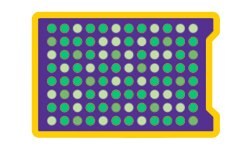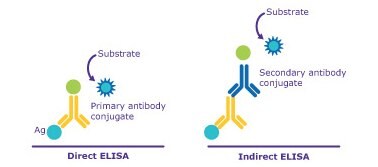Complete Solutions for IVD Chemiluminescent Immunoassay (CLIA/CLEIA) Development
Your Partner from Concept to Clinic
CLIA/CLEIA assays provide sensitive and high-throughput target detection

Chemiluminescent immunoassays (CLIA) combine the advantages of chemiluminescence sensitivity with the specificity of an immunoreaction. In this technique, an enzyme converts a substrate into a chemiluminescent signal that is emitted as photons of light in the visible or near visible range. The amount of light produced correlates to the amount of target analyte present in the sample.
CLIA assays provide a sensitive, high-throughput alternative to conventional colorimetric ELISA methods. Although the underlying principles are the same, the colorimetric substrate is replaced by a chemiluminescent substrate in CLIA assays.
In general, chemiluminescent substrates should provide the following advantages:
- Fast reaction time
- High signal-to-noise ratio
- Long-lived emission signal
- Stability at room temperature for the duration of the assay
- Emission that is compatible with all microplate* formats and sizes, and amenable to automation and high-throughput screening
* Microplate selection: to develop a reliable CLIA assay, it is crucial to select a microplate that is suitable for luminescence. Plates are usually opaque white with solid white or clear-bottomed wells to avoid background and cross talk.
Ultimately, the target analyte is quantified by measuring the light intensity generated by the chemiluminescent immunoreaction. Luminescence is measured in Relative Light Units (RLU) by a luminometer, where RLUs are typically proportional to the amount of target analyte present in the sample.
Importantly, CLIA assays are one of the most sensitive detection methods due to signal multiplication and amplification. The technique can detect small concentrations of biological molecules (limit of detection = zeptomole 10-21 mol). In the presence of enhancers, chemiluminescent reactions occur for even longer without a reduction in the light output. Substrate can be added only minutes before detection and there is no requirement for a long incubation period nor a need for stopping reagents, as is the case with conventional colorimetric ELISA assays.
Key Types of Chemiluminescent Immunoassay Methods:
- Indirect CLIA, using enzyme markers
This common CLIA method involves an enzyme, typically horse radish peroxidase (HRP) or alkaline phosphatase (AP), conjugated to a secondary antibody. This HRP– or AP–secondary antibody complex then catalyzes the conversion of chemiluminescent substrate, luminol and CSPD reagent [Disodium 3-(4-methoxyspiro {1,2-dioxetane-3,2′-(5′-chloro)tricyclo [3.3.1.13,7]decan}-4-yl)phenyl phosphate], respectively. These substrates, when oxidized, provide an easy means of signal detection and quantification due to prolonged signal emission.
Oxidation of luminol by hydrogen peroxide produces light emission at 425 nm. The addition of enhancers [e.g., potassium ferricyanide (red prussiate), potassium periodate] further boosts electron activation, leading to elevated analytic sensitivity.
- Direct CLIA, using luminophore markers
This method commonly uses acridinium esters as luminophores conjugated directly to the primary monoclonal antibody to generate a signal. Acridinium esters are highly specific labels that spontaneously oxidize in the presence of alkaline hydrogen peroxide, yielding a signal at 429 nm within 2 seconds, compared to luminol which generates a longer lasting signal.
Find detailed protocols to perform direct and indirect CLIA and ELISA assays.

Enzymes, Luminophores, Substrates and Enhancers – Enabling your chosen detection method
- Horseradish peroxidase (HRP)
- HRP enzyme
- HRP substrates: luminol, optimized substrate for chemiluminescence assays, chemiluminescent substrate with
stabilized hydrogen peroxide, Luminata™ ELISA HRP substrates, and other substrates for chemiluminescence and
ELISA
- Enhancers of luminol and a signal enhancer kit
- Technical information - Alkaline Phosphatase (AP)
- AP enzyme
- AP substrate and enhancer
- Technical information - Other reagents that can be conjugated to HRP and AP for use in chemiluminescence assays: Streptavidin reagents, ExtrAvidin® reagent, avidin reagents, avidin-biotin complex reagents
- Acridinium esters: These luminophores can only be used in conjunction with luminescent detectors equipped to handle “flash” reactions which are transient in nature and reach maximum intensity within seconds
Antibody Portfolio and Custom Services – Take advantage of a broad product offering, supported by the expertise and customization you require
- Over 90,000 antibodies targeting a wide variety of clinical conditions
- Secondary antibodies specific for commonly used species, and antibody subtypes with a range of conjugation options (e.g., peroxidase-, alkaline phosphatase- and biotin-labeled antibodies
- Information on choosing a secondary antibody - In-house manufacture of monoclonal antibodies to all human immunoglobulin subtypes, including anti-human IgM
- Custom antibody and protein production and conjugation services
Reagents for Antibody and Protein Production – Helping you manufacture the assay components you need
- Immunization adjuvants - KLH and BSA carrier proteins, Freund’s adjuvant
- Routine cell culture - Media, sera, supplements, additives, antibiotics
- Hybridoma support reagents - Hybri-Max™ specialist media, supplements, reagents
- Purification resins and reagents
- Protein A, Protein G, Protein L resins
- Size exclusion and ion exchange resins
- Ammonium sulfate
- Cyanogen bromide-activated agarose for affinity chromatography
Blocking Agents – Secure the quality reagents you require for your assay's performance
- Wide range of Bovine Serum Albumins (BSA), including Probumin® for IVD applications
- Blocking buffers including carbonate-bicarbonate buffer and casein blocking buffer, as well as blocking reagents
- ChemiBlock™ - Active, passive, and isotype-specific blocking agents produced for IVD manufacturers
- Alternative blockers, including sera from non-bovine sources and purified immunoglobulins
Estapor® Magnetic and Polymeric Microspheres – Benefit from a consistent, sensitive and flexible range of assay enhancing options. Discover the possibilities in assay automation and purification through:
- Magnetic core polymeric beads
- Functionalized (Amino, carboxyl) or non-functionalized surfaces
- Customized coatings and conjugations
Off-the-Shelf Chemiluminescent Kits – Customizable according to your needs
One-Stop Shop for Ancillary Reagents – Simplicity and convenience to accelerate your commercialization
- In-house manufacturer of all types of biological buffers
- Tris, bicarbonate, phosphate, borate, citrate
- ELITE buffers for IVD manufacturers - Detergents and surfactants including SDS, TWEEN®, sodium deoxycholate, CHAPS, PVA, PEG, and PVP
- Protease inhibitors - Cocktails and individual components
- Phosphatase inhibitors - Cocktails and individual components
- Proteins and peptides
- Acids, bases and salts
- Preservatives - sodium azide and the IVD biocide ProClin™
- Water and Milli-Q® water purification systems
- Consumables: Nunc Microplates and sealing films, Corning microplates, and cell culture plasticware
Download our brochure for a comprehensive list of ELISA kits and to search ELISA analysis kits by target or gene name which can be customized based on your CLIA assay needs.
Simplify CLIA/CLEIA assay development and manufacture with a partner who understands the IVD market
Accelerate your time to market with fit-for-use products which offer the quality, consistency, and documentation necessary for every step of your IVD development and manufacturing needs.
Proven Expertise in Immunoassay Development
Leverage our extensive immunoassay development knowledge, based on in-depth product development and manufacturing experience, and supported by IVD industry partnerships.
Discover the Value of Partnering from Concept to Clinic
By partnering with us early in development to source raw materials, you help to ensure a smooth and efficient transfer from R&D through to commercialization.
We offer:
- Product selection assistance
- Risk mitigation support
- Clear quality and supply chain guidelines
- A reliable and transparent global supply chain
- Proactive forecasting
- Superior documentation
- Regulatory insight
Impact of Early Supplier Involvement:


In addition to letting you design and order your custom DNA and RNA oligos and qPCR probes, we offer years of experience in critical and non-critical raw material manufacturing, supporting a full range of custom and contract manufacturing services for diagnostic manufacturers.
Let us partner with you from the development of the initial concept, through to scale up and final manufacturing. We ensure that you have quality products, at the optimal scale, at the right time, to aid your rapid commercialization.
Gain the Flexibility to Meet all Your Manufacturing Needs:
- Bulk configured reagents
- Customized packaging and labeling
- Custom reagent formulation
- Custom QC and assay support
To continue reading please sign in or create an account.
Don't Have An Account?